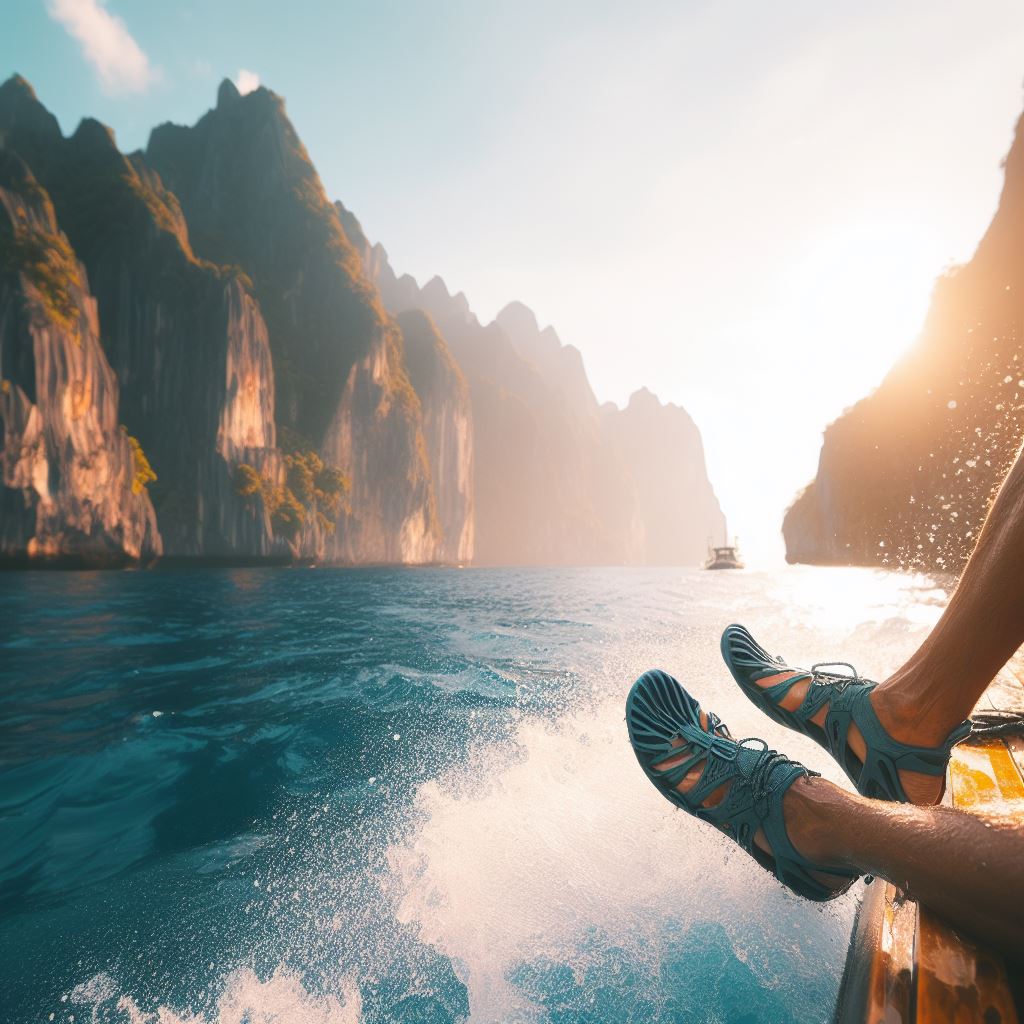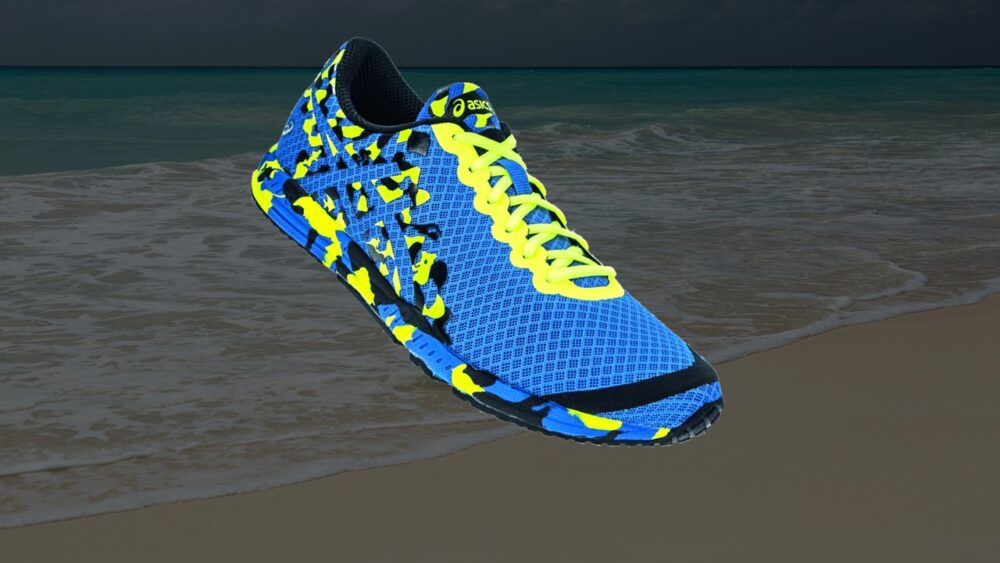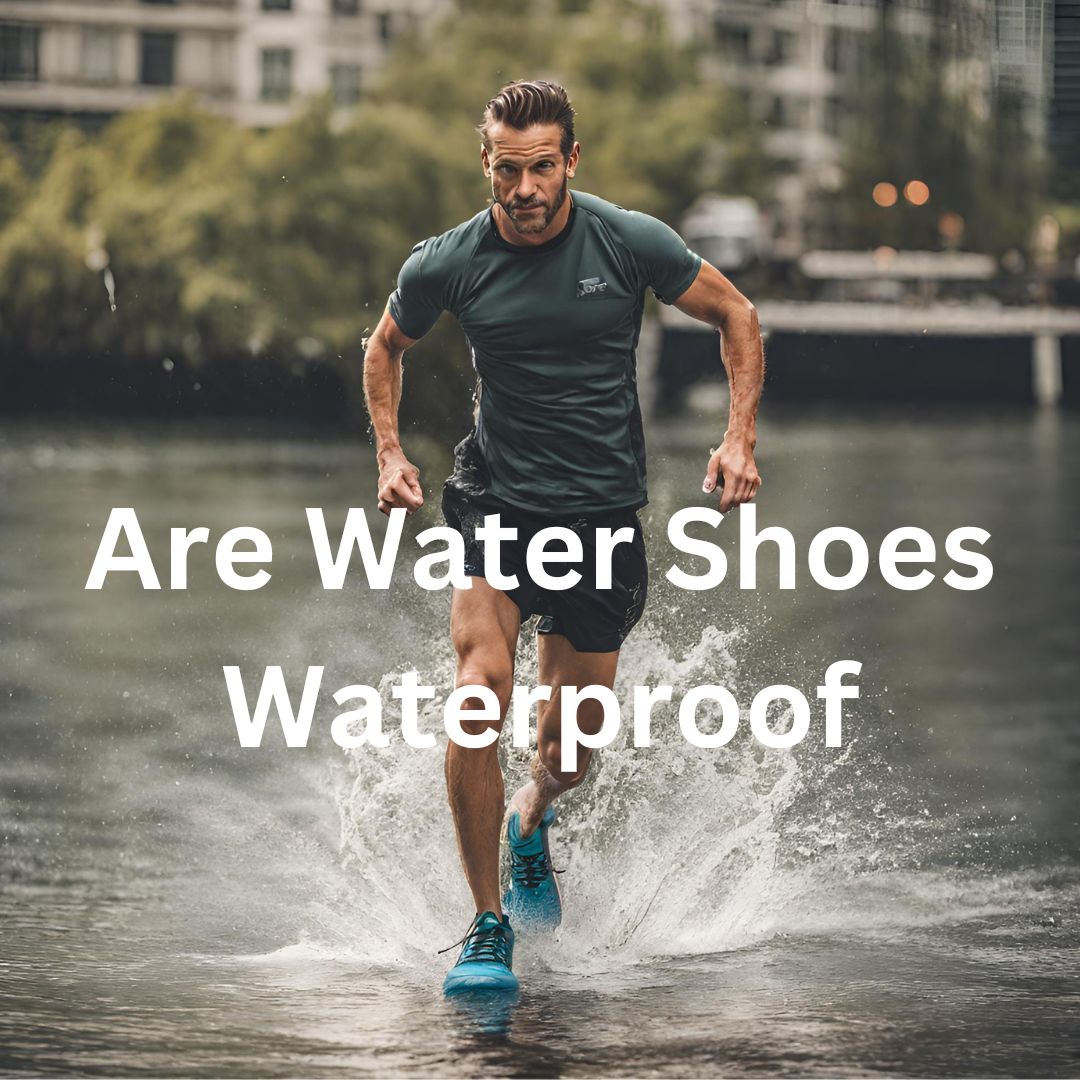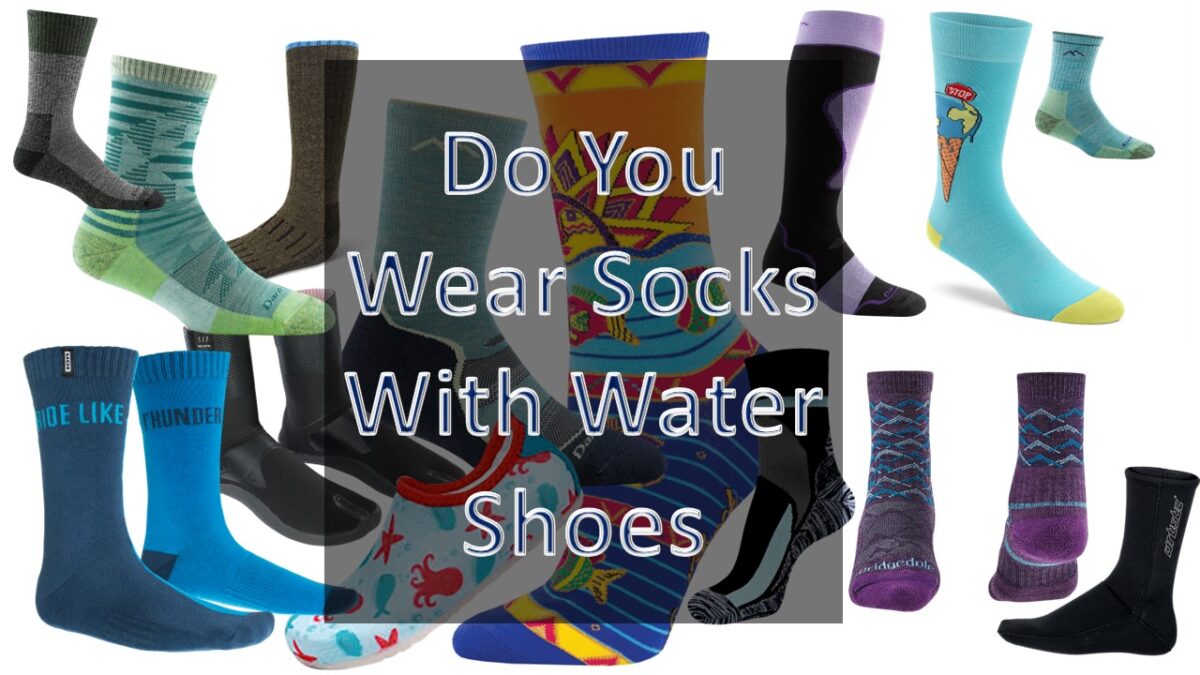How Should Water Shoes Fit – Should They Be Tight Or Loose?
Looking for an answer to the common question “How should water shoes fit?” Water shoes should fit snugly, but not too tight. They should be able to provide your feet with stability and support. They should not be constricting but feel secure.
No one should wear incorrectly fitted water shoes. Research showed that wrongly fit shoes can cause foot pain and foot disorder. No one deserves foot pain or foot disorder because they want to have fun around water. So, shoe sizing is important.
I have researched it and will explain everything you need to know about buying the right water shoe size in this blog post. If you want an answer to “How should water shoes fit?” read on.
Exactly How Should Water Shoes Fit?
Having fun around water is common among us from partying on a boat to different water sports. But how should water shoes fit? If you want to have optimal fun in and around water, you need the best water shoes in the right size.
Water shoes should fit snugly but not too tightly. They should be super comfortable and allow for a great range of movement while also providing you with optimal support.
Water shoes should be supportive and feel secure without constricting your feet. Your toes should have enough room to wiggle and be comfortable. However, the toe room should not be too wide to avoid foot slippage in the shoes.
Also, water shoes should be snug around the heel to avoid slipping but should not be too tight to cause blisters and discomfort. Overall, water shoes should be super comfortable and secure on your feet.
What Features Should You Look For In A Perfectly Fit Water Shoe (How Should Water Shoes Fit)
When participating in water activities, wearing water shoes that fit properly is crucial. Shoes that are too big can cause blisters and chafing, while shoes that are too small can be uncomfortable and constrictive.
Water shoes should be snug but not tight, and they should allow your feet to move and breathe easily. Here is what you should look for in a perfectly fit water shoe:
1. Size
All shoes do not fit the same. In some shoes, you have to buy your original size, in some, you have to size up or down. This is why you should try the shoes before buying them.
Even if you buy your water shoes online, make sure to buy them where you can return them if the shoes are ill-fit. When you are purchasing your shoes, it is good to try them on in the afternoon when your feet are always at their largest.
Before you order a shoe online, make sure to measure your feet and choose the right size. If you will be wearing socks or insoles with your shoes, you should consider the thickness of the socks when you are measuring your feet.
Since your foot comfort is paramount, you should also consider your foot width too.
2. Toe Room
There should be enough room for your toes to wiggle but should not be too much to make your feet slip around in the shoe.
3. Heel Grip
The heel of water shoes should fit snugly but not too tight to cause blisters. They should not slip up or down while you are wearing them. The upper part of the shoes should also not be too tight. When the upper is too tight, it can cause chafing.
4. Arch Support
If you have arch issues, your best bet is water shoes with arch support. Everyone needs arch support but people with arch issues need it more. So, make sure the shoe’s arch support matches the kind of arch you have.
5. All-round Comfort
All round comfort is important in every shoe but is even more important in water shoes. Try on the shoe in the afternoon and make sure that every part of your foot is comfortable in the shoe.
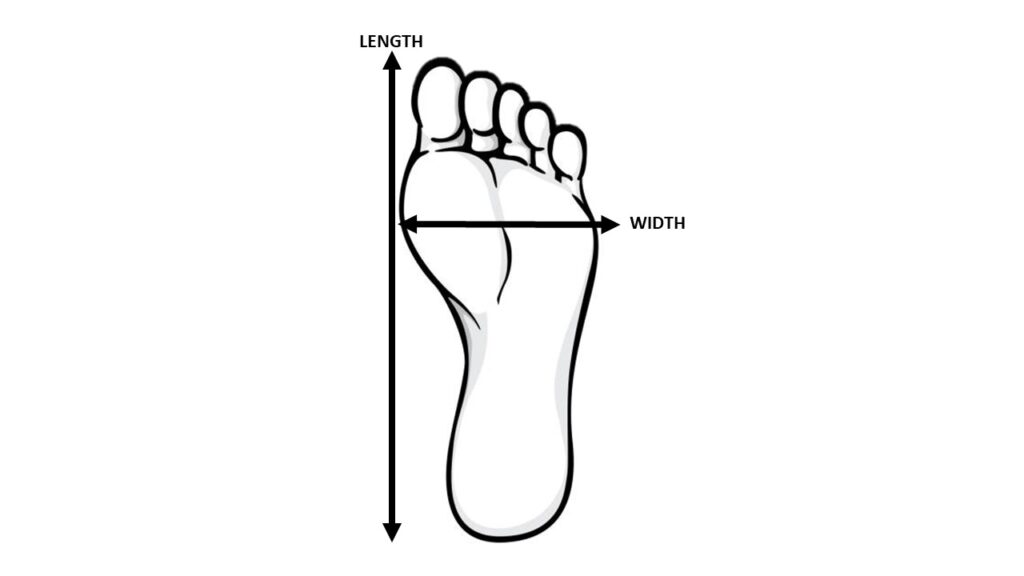
How To Measure Your Feet For Water Shoes (How Should Water Shoes Fit)
In order to find the perfect fitting water shoes, you’ll need to measure your feet. Follow these simple steps to get an accurate measurement:
- Place a piece of paper on the floor and stand on it with your bare feet.
- Use a pen or pencil to trace around your foot.
- Measure the length of your foot from your longest toe to the heel.
- Measure the width of your foot at the widest point.
- Repeat the same process for the second foot.
- Compare the measurement with your water shoe manufacturer’s size chart.
- Consider the thickness of the socks you would like to wear with the shoe and add extra space to the measurement accordingly.
It is necessary to measure both feet because the size may not be the same. Ensure you choose the size that fits your larger foot for optimum comfort.
Measuring your feet is a quick and easy way to ensure you get the right size water shoes. By taking just a few minutes to measure your feet, you’ll be able to find shoes that fit you well and keep you comfortable all day long.
Water Shoe Size Chart (How Should Water Shoes Fit)
Here’s a sample water shoe size chart to give you an idea of how the sizes may be listed:
Men Water Shoe Size Chart
| US | EU | UK | CM |
| 5 | 37.5 | 4.5 | 23 |
| 5.5 | 38 | 5 | 23.5 |
| 6 | 38.5 | 5.5 | 24 |
| 6.5 | 39 | 6 | 24.5 |
| 7 | 40 | 6 | 25 |
| 7.5 | 40.5 | 6.5 | 25.5 |
| 8 | 41 | 7 | 26 |
| 8.5 | 42 | 7.5 | 26.5 |
| 9 | 42.5 | 8 | 27 |
| 9.5 | 43 | 8.5 | 27.5 |
| 10 | 44 | 9 | 228 |
| 10.5 | 44.5 | 9.5 | 28.5 |
| 11 | 45 | 10 | 29 |
| 11.5 | 45.5 | 10.5 | 29.5 |
| 12 | 46 | 11 | 30 |
| 13 | 47.5 | 12 | 30.5 |
| 14 | 48.5 | 13 | 31 |
| 15 | 49.5 | 14 | 31.5 |
| 16 | 50.5 | 15 | 32 |
| 17 | 51.5 | 16 | 32.5 |
| 18 | 52.5 | 17 | 33 |
Women Water Shoes Size Chart
| US | EU | UK | CM |
| 5 | 35.5 | 2.5 | 22 |
| 5.5 | 36 | 3 | 22.4 |
| 6 | 36.5 | 3.5 | 22.9 |
| 6.5 | 37.5 | 4 | 23.3 |
| 7 | 38 | 4.5 | 23.7 |
| 7.5 | 38.5 | 5 | 24.1 |
| 8 | 39 | 5.5 | 24.5 |
| 8.5 | 40 | 6 | 25 |
| 9 | 40.5 | 6.5 | 25.4 |
| 9.5 | 41 | 7 | 25.8 |
| 10 | 42 | 7.5 | 26.2 |
| 10.5 | 42.5 | 8 | 26.7 |
| 11 | 43 | 8.5 | 27.1 |
| 12 | 44.5 | 9.5 | 27.9 |
What Are The Types Of Fits In Water Shoes? (How Should Water Shoes Fit)
Since perfectly fit shoe importance cannot be exchanged for anything else, here are the types of fits in water shoes:
- Snug fit: these shoes will hug your foot closely, providing a lot of support. They are perfect for kayaking, water aerobics and swimming, where a secure fit is paramount.
- Loose fit: these shoes will be roomier, allowing your foot to breathe.
- Wide fit: These are perfect for people with wide feet. They provide you with more room for optimal comfort.
- Adjustable fit: these shoes will have straps or laces that you can tighten or loosen, depending on your needs.
The type of fit you choose will depend on your personal preference and the activities you’ll be using the shoes for.
If you are planning on doing a lot of swimming, for instance, you’ll probably want a snugger fit so that your shoes don’t fall off. But a loose fit might be more comfortable if you’re just doing some light wading.
No matter what type of fit you choose, make sure to try the shoes on before you buy them to ensure they are comfortable. Try them on in the afternoon on dry land.
RELATED: How To Clean Water Shoes The Right Way
Factors To Consider When Trying On Water Shoes (How Should Water Shoes Fit)
There are several different types of water shoes on the market, and it can be tough to know which one is right for you. There are a few factors you should consider when trying on water shoes:
- The type of water activity you’ll be doing: Will you be swimming, stand-up paddle boarding, kayaking, or doing something else?
- The fit: Make sure the water shoes are comfortable and fit well. You don’t want them to be too tight or too loose.
- The style: There are different styles of water shoes, so choose the one that you think looks best.
- Material: Shoes made with durable material are better if you want to avoid buying new shoes all the time. Also, the shoes should dry quickly and hold up to repeated exposure to water.
- Traction: Check the sole of the shoe and ensure it offers excellent traction on wet surfaces. If you choose shoes with a non-slip sole, you can avoid slipping and falling when in the water.
- Flexibility: Ensure the shoes are flexible enough to allow you a full range of motion while still getting enough support for your feet.
- The price: Water shoes can range in price, so choose the ones that fit your budget.
- Support: Water shoes should provide your feet and ankle with ample support, especially if you will be participating in water sports such as stand-up paddleboarding or kayaking.
Keep these factors in mind when trying on water shoes, and you’ll be sure to find the perfect pair for you.
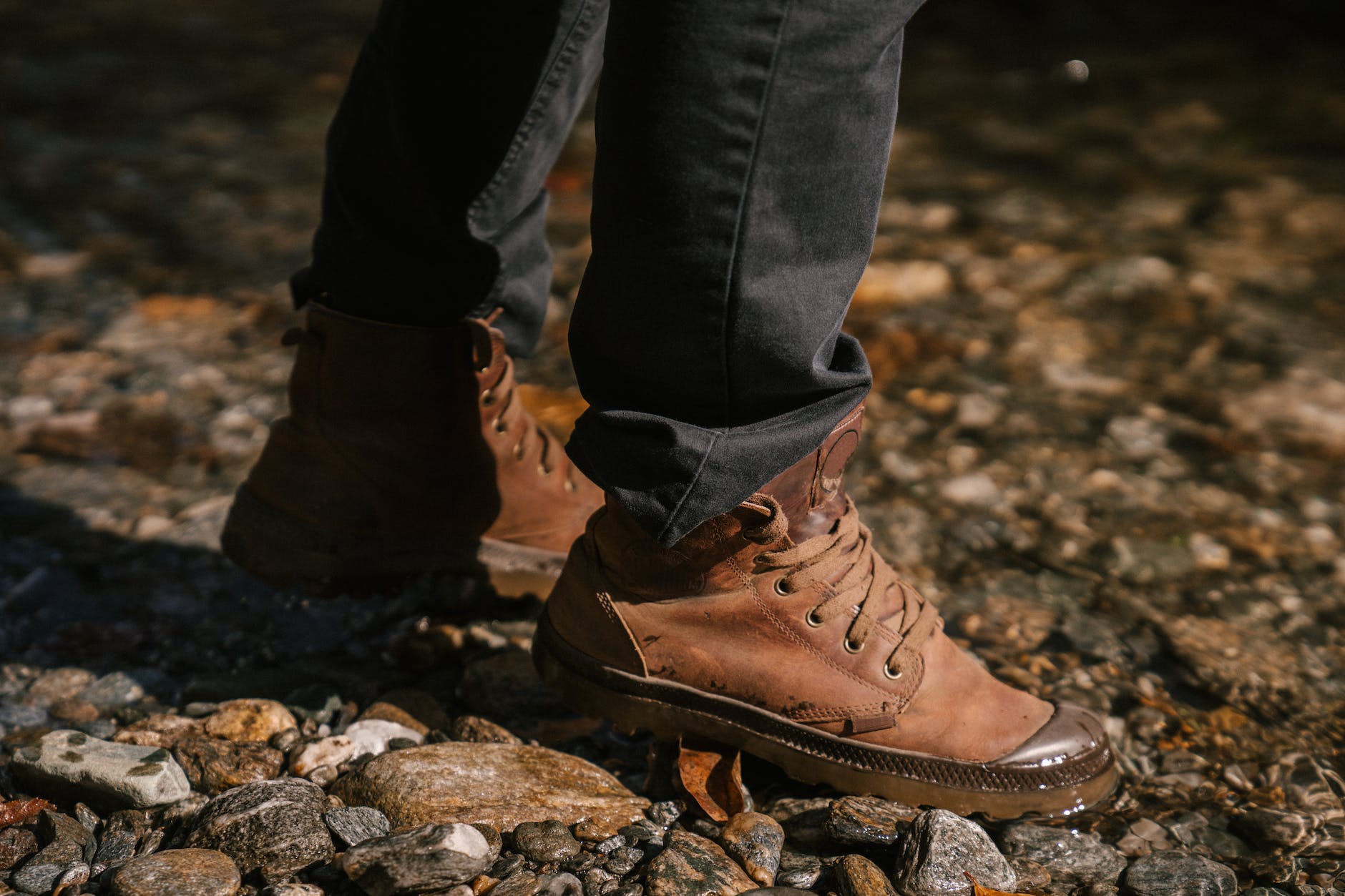
Importance Of Proper Fit In Water Shoes (How Should Water Shoes Fit)
When engaging in water activities, it is important to have the proper footwear to ensure safety and performance. There are many factors to consider when choosing water shoes, but one of the most important is fit.
Properly fitting water shoes will provide more support and stability, which can help prevent injuries. They will also be more comfortable to wear, allowing you to focus on enjoying your time in the water. Here is the importance of proper fit in water shoes:
- Comfort: Excellently fitting water shoes can prevent chafing, blisters, pain, heel rubbing and other foot injuries. It also ensures your feet are comfortable during water activities.
- Safety: Perfectly fit shoes will fit snugly and securely, preventing slips and falls in a slippery or wet area.
- Protection: Water shoes that fit well will provide your feet with perfect protection, shielding them from abrasions, cuts and other injuries.
- Performance: Shoes that fit should improve stability and traction in water, letting you perform better and more safely during water activities.
- Foot fatigue prevention: If your shoe fits properly, it will help you reduce fatigue by reducing the amount of stress your feet receive during water activities.
When your water shoes fit properly, you will feel safe, comfortable and able to perform at your best in any water activity you are involved in.
RELATED: How To Get The Smell Out Of Water Shoes Instantly
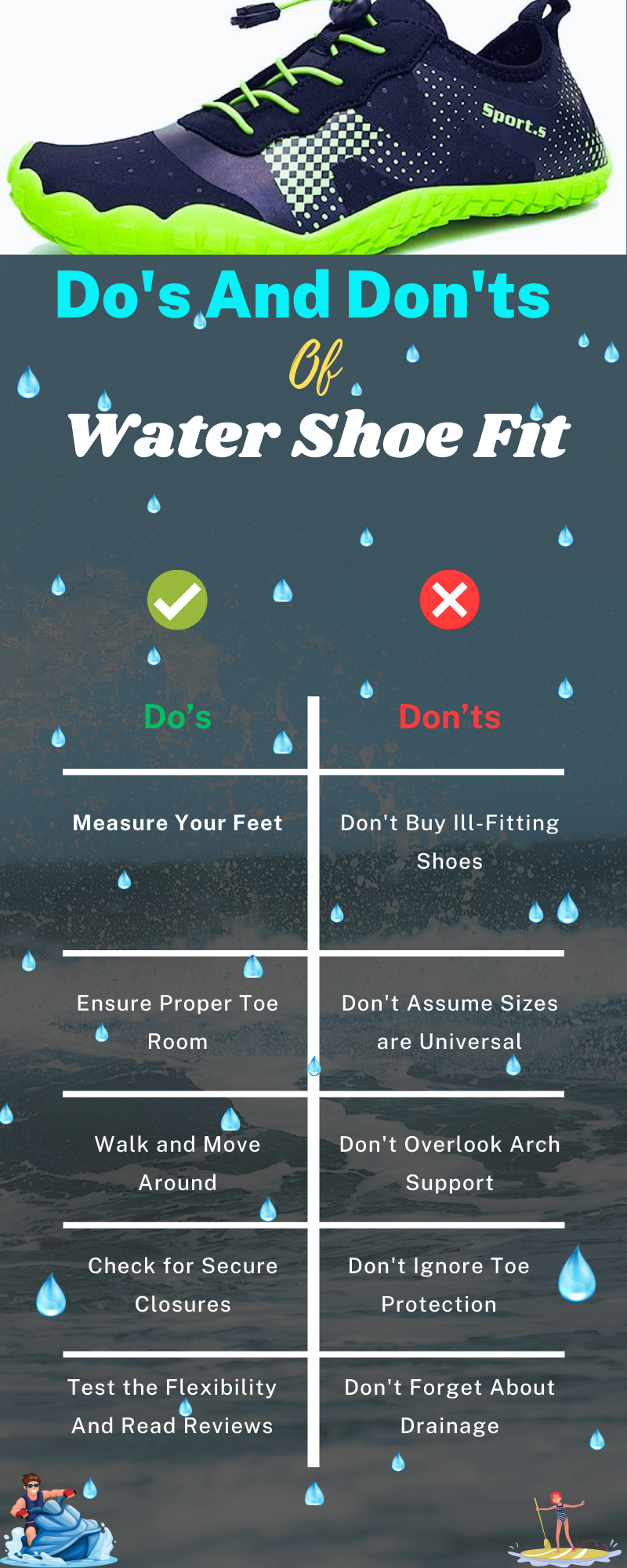
Common Mistakes To Avoid When Buying Water Shoes (How Should Water Shoes Fit)
When buying water shoes, it is important to avoid the following common mistakes:
- Not trying them on: Always try on the shoes in the afternoon on dry land and walk around to make sure they fit comfortably. Different brands may have different fits, even if they are labeled the same size.
- Not measuring your feet: Make sure to measure your feet and compare them to the size chart provided by the manufacturer. This will help ensure you choose the correct size.
- Not considering the type of water activity: Some water shoes are designed specifically for certain activities, such as snorkeling or kayaking. Make sure to choose a shoe that is suitable for the activities you will be participating in.
- Ignoring comfort: Avoid shoes that squeeze your feet or rub in any way. Look for shoes with a cushioned insole and a comfortable fit.
- Choosing poor-quality materials: Look for shoes made with durable, quick-drying materials that will hold up to repeated exposure to water.
- Not checking for traction: Check the sole of the shoe to make sure it provides good traction on wet surfaces. Shoes with a non-slip sole will help prevent slips and falls.
- Not considering the fit: Make sure the shoes provide enough support but still allow for a full range of motion. Consider choosing shoes with a snug, regular, or wide fit, depending on your type of foot.
- Not considering the shoes’ weight: Avoid shoes with too much cushioning. Water shoes should be lightweight and have a slim design to help you move easily in the water.

What Are The Best Water Shoes Recommendation (How Should Water Shoes Fit)
Here are some highly rated water shoes:
- Speedo Men’s Surfwalker Pro 2.0 Water Shoe
- Aleader Women’s Quick Drying Aqua Water Shoes
- Columbia Men’s Drainmaker IV Water Shoe
- SIMARI Water Shoes Women Mens
- Merrell Men’s All Out Blaze Sieve Water Shoe
- VIFUUR Men Women Water Aqua Shoes
- DLGJPA Men’s Lightweight Quick Drying Aqua Water Shoes
- Mishansha Mens Womens Water Shoes Quick Dry
These recommendations are based on the average customer ratings and the number of reviews. It is always best to check the product description and customer reviews to ensure the water shoes meet your specific needs and preferences.
Do Water Shoes Stretch When Wet (How Should Water Shoes Fit)
Water shoes can stretch when wet, especially if they are made of neoprene or another stretchy material. However, the amount of stretching varies depending on the specific type of water shoe and the material it is made from.
Some water shoes are designed to be snug-fitting to provide better protection and support, while others are designed to be more flexible and allow for a looser fit.
Ultimately, the degree of stretching will depend on a variety of factors, including the materials used, the design of the shoe, and the amount of water it is exposed to.

The Right Amount Of Flexibility In Water Shoes (How Should Water Shoes Fit)
Having the right amount of flexibility in water shoes is essential for several reasons:
- Natural Movement: Water shoes with proper flexibility allow your feet to move more naturally, providing a more comfortable and unrestricted feeling during water activities. This is especially important for activities that involve swimming, kayaking, or snorkeling.
- Improved Performance: When your water shoes have the right amount of flexibility, you can move more efficiently in the water. Whether you are swimming, wading, or engaging in water sports, flexible shoes can enhance your performance and agility.
- Comfort and Reduced Fatigue: Flexible water shoes adapt to the natural contours of your feet, reducing discomfort and fatigue during prolonged use. This is particularly important if you plan to wear them for extended periods or participate in activities like hiking or beach walking.
- Balance and Traction: Proper flexibility allows the shoe to mold to uneven surfaces, enhancing your balance and stability. It also improves the shoes’ ability to grip slippery surfaces, reducing the risk of slips and falls.
- Protection from Hazards: While flexibility is crucial, water shoes must still offer enough support to protect your feet from rocks, shells, and other potential hazards in the water. Striking the right balance ensures that your feet remain safe during your water activities.
- Versatility: Water shoes with appropriate flexibility can be more versatile, allowing you to use them for various water-related activities. Whether you are walking on the beach, exploring rocky shorelines, or participating in water sports, the shoes should adapt to different conditions.
- Preventing Blisters and Chafing: Shoes that are too rigid or lack flexibility can cause friction against your skin, leading to blisters and chafing. Properly flexible water shoes can minimize these issues and provide a more comfortable experience.
- Quick Drying: Flexible water shoes often feature materials with better water-draining capabilities. This ensures that excess water can quickly escape from the shoe, keeping your feet dry and reducing the risk of skin problems like athlete’s foot.
- Reduced Weight: Water shoes with the right amount of flexibility tend to be lighter, which can be advantageous during water-based activities that require swift movements.
- Longevity: Shoes with appropriate flexibility are less prone to damage and stress. They can better withstand the strains of outdoor water activities, resulting in a longer lifespan for the footwear.
RELATED: Best Sports Water Bottles – Perfect For Everyone
Water Shoes Size Up Or Down (How Should Water Shoes Fit)
The sizing of water shoes can vary depending on the brand and style, so it’s essential to check each manufacturer’s specific sizing guidelines. But, if your size is in between (e.g. size 8.5 or 9.5) and the shoe is only available in whole sizes (e.g. size 8 or 9), you can size down by half.
However, as a general rule of thumb, most experts recommend sizing water shoes based on the following considerations:
- Go True to Size: For many people, choosing water shoes in their regular shoe size is a safe bet. This is especially true if you plan to wear them for water activities where a secure fit is essential, such as swimming or water sports.
- Consider Activity and Use: If you plan to wear water shoes for casual walking or beach activities, sticking to your regular shoe size is usually appropriate. However, if you intend to wear them for water hiking or other more intense activities, you might consider sizing up slightly to accommodate thicker water socks or provide more comfort during extended wear.
- Fit with Water Socks: If you intend to wear neoprene or other types of water socks with your water shoes for added insulation or protection, you might need to size up to ensure a comfortable fit with the socks on.
- Check Manufacturer’s Guidelines: Always refer to the specific sizing chart or guidelines provided by the manufacturer of the water shoes you are considering. Different brands may have their sizing system, and some may recommend sizing up or down based on their design.
- User Reviews and Recommendations: It can be helpful to read user reviews or seek recommendations from others who have already purchased the same water shoes. They might provide valuable insights into the fit and sizing of the specific model you are interested in.
- Try Before You Buy: If possible, try on the water shoes in-store or order from a retailer with a good return policy, so you have the option to exchange them for a different size if needed.
- Consider Width: Besides length, consider the width of the water shoes, especially if you have wider feet. Some brands offer various width options to accommodate different foot shapes.
Ultimately, the best approach is to consider your intended use, read reviews, and check the manufacturer’s sizing guidelines to make an informed decision. Keep in mind that a proper fit is essential for comfort, performance, and safety during water activities.
Wearing Water Shoes Everyday (How Should Water Shoes Fit)
Wearing water shoes every day can be practical in certain situations especially if you are a water sports enthusiast, but there are a few considerations to keep in mind:
- Comfort and Support: Water shoes are designed to provide support and protection during water-related activities. While they are generally comfortable for short periods, wearing them every day for extended periods might not be as comfortable as regular shoes that are specifically designed for daily wear.
- Durability: Frequent daily use may lead to more rapid wear and tear on water shoes, especially if they are not designed for constant use on rough surfaces.
- Style and Versatility: Water shoes are often designed with functionality in mind, which may not always align with everyday fashion preferences. Consider whether the style and appearance of water shoes match your daily attire.
- Weather and Climate: Wearing water shoes every day might be more suitable in warmer climates or during the summer season when outdoor water activities are more common. In colder weather, they may not provide enough insulation or protection.
- Alternate Footwear: If you plan to wear water shoes every day, consider alternating with other appropriate footwear to give your feet a break and avoid potential foot-related issues.
- Indoor Use: If you’re wearing water shoes daily and transitioning between indoor and outdoor environments, be mindful of potential slips on smooth indoor surfaces.
- Fit and Comfort: Ensure that your water shoes fit well and provide enough comfort for daily use. An ill-fitting or uncomfortable pair may lead to foot pain or discomfort.
Wearing water shoes every day is feasible, but it’s essential to consider comfort, foot hygiene, durability, and the appropriateness of the shoes for daily use.
Depending on your lifestyle, you may find it more practical to alternate between water shoes and other types of footwear to maintain foot health and ensure comfort throughout the day.
The Bottom Line On How Should Water Shoes Fit
If you are looking for an answer to “how should water shoes fit,” it is important that water shoes fit well in order to provide the best possible support and protection. Ill-fitting water shoes can cause a number of problems, including blisters, calluses, and cramped toes.
To ensure a good fit, water shoes should be snug but not too tight, with enough room to wiggle the toes. They should also provide good support around the ankles and be easy to walk in. When trying on water shoes, it is important to wear the same type of socks you would typically wear for water sports.
